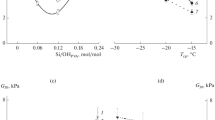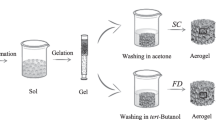Abstract
Poly(aniline-co-m-phenylenediamine) cryogels supported by poly(vinyl alcohol) were obtained by oxidative cryocopolymerization of aniline and m-phenylenediamine in the presence of poly(vinyl alcohol) in the frozen aqueous medium. Morphology, specific surface area, and mechanical properties of aerogels obtained after freeze-drying with pore size up to 35 μm were dependent on initial freezing temperature and total concentration of comonomers in polymerization mixture. The materials initially frozen at higher temperatures and synthesized at higher comonomers concentrations were found to have in general smaller pore sizes and consequently better mechanical stability. Initial freezing temperature − 24 °C and total comonomer concentration 0.77 M were found to be the optimum parameters for the preparation of conducting cryogels with conductivity of solid phase 1 × 10−3 S cm−1, a relatively high specific surface area 23.1 m2 g−1, and excellent mechanical properties with tensile modulus 255 kPa. The molecular structure of cryogels is discussed with the help of FTIR and Raman spectra.




Similar content being viewed by others
References
Stejskal J (2017) Conducting polymer hydrogels. Chem Pap 71:269–291. https://doi.org/10.1007/s11696-016-0072-9
Chakraborty P, Das S, Nandi AK (2019) Conducting gels: a chronicle of technological advances. Prog Polym Sci 88:189–219. https://doi.org/10.1016/j.progpolymsci.2018.08.004
Sahiner N, Demirci S (2016) In situ preparation of polyaniline within neutral, anionic, and cationic superporous cryogel networks as conductive, semi-interpenetrating polymer network cryogel composite systems. J Appl Polym Sci 133:44137. https://doi.org/10.1002/app.44137
Liu Q, Wu JH, Lan Z, Zheng M, Yue GT, Lin JM, Huang ML (2015) Preparation of PAA-g-PEG/PANI polymer gel electrolyte and its application in quasi solid state dye-sensitized solar cells. Polym Eng Sci 55:322–326. https://doi.org/10.1002/pen.23900
Tang ZY, Wu JH, Liu Q, Zheng M, Tang QW, Lan Z, Lin JM (2012) Preparation of poly(acrylic acid)/gelatin/polyaniline gel-electrolyte and its application in quasi-solid-state dye-sensitized solar cells. J Power Sources 203:282–287. https://doi.org/10.1016/j.jpowsour.2011.11.039
Al-Sagur H, Sundaram KS, Kaya EN, Durmus M, Basova TV, Hassan A (2019) Amperometric glucose biosensing performance of a novel graphene nanoplatelets-iron phthalocyanine incorporated conducting hydrogel. Biosens Bioelectron 139:111323. https://doi.org/10.1016/j.bios.2019.111323
Zhao Y, Li ZH, Song SL, Yang KR, Liu H, Yang Z, Wang JC, Yang B, Lin Q (2019) Skin-inspired antibacterial conductive hydrogels for epidermal sensors and diabetic foot wound dressings. Adv Funct Mater 29:1901474. https://doi.org/10.1002/adfm.201901474
Hu CX, Zhang YL, Wang XD, Xing L, Shi LY, Ran R (2018) Stable, strain-sensitive conductive hydrogel with antifreezing capability, remoldability, and reusability. ACS Appl Mater Interfaces 10:44000–44010. https://doi.org/10.1021/acsami.8b15287
Li WX, Shu D, Han HL, Ma ZF (2018) An amperometric immunoprobe based on multifunctional nanogel for sensitive detection of tumor marker. Sens Actuator B-Chem 273:1451–1455. https://doi.org/10.1016/j.snb.2018.07.067
Deng ZX, Guo Y, Ma PX, Guo BL (2018) Rapid thermal responsive conductive hybrid cryogels with shape memory properties, photothermal properties and pressure dependent conductivity. J Colloid Interface Sci 526:281–294. https://doi.org/10.1016/j.jcis.2018.04.093
Wang ZW, Zhou HW, Lai JL, Yan B, Liu HB, Jin XL, Ma AJ, Zhang G, Zhao WF, Chen WX (2018) Extremely stretchable and electrically conductive hydrogels with dually synergistic networks for wearable strain sensors. J Mater Chem C 6:9200–9207. https://doi.org/10.1039/C8TC02505C
Sahiner N, Demirci S (2017) The use of p(4-VP) cryogel as template for in situ preparation of p(An), p(Py), and p(Th) conductive polymer and their potential sensor applications. Synth Met 227:11–20. https://doi.org/10.1016/j.synthmet.2017.03.003
Sahiner N, Demirci S, Aktas N (2017) Superporous cryogel/conductive composite systems for potential sensor applications. J Polym Res 24:126–111. https://doi.org/10.1007/s10965-017-1288-2
Bai YK, Zhang JW, Chen X (2018) A thermal-, water-, and near-infrared light-induced shape memory composite based on polyvinyl alcohol and polyaniline fibers. ACS Appl Mater Interfaces 10:14017–14025. https://doi.org/10.1021/acsami.8b01425
Srinivasan A, Roche J, Ravaine V, Kuhn A (2015) Synthesis of conducting asymmetric hydrogel particles showing autonomous motion. Soft Matter 11:3958–3962. https://doi.org/10.1039/C5SM00273G
Shi Y, Ma C, Peng L, Yu G (2015) Conductive “Smart” hybrid hydrogels with PNIPAM and nanostructured conductive polymers. Adv Funct Mater 25:1219–1225. https://doi.org/10.1002/adfm.201404247
Huang HB, Chen RP, Yang SY, Li L, Liu YL, Huang J (2019) Facile fabrication of MnO2-embedded 3-D porous polyaniline composite hydrogel for supercapacitor electrode with high loading. High Perform Polym UNSP 0954008319860893. https://doi.org/10.1177/0954008319860893
Niu ZQ, Zhou WY, Chen XD, Chen J, Xie SS (2015) Highly compressible and all-solid-state supercapacitors based on nanostructured composite sponge. Adv Mater 27:6002–6008. https://doi.org/10.1002/adma.201502263
Moussa M, Zhao ZH, El-Kady MF, Liu HK, Michelmore A, Kawashima N, Majewski P, Ma J (2015) Free-standing composite hydrogel films for superior volumetric capacitance. J Mater Chem A 3:15668–15674. https://doi.org/10.1039/C5TA03113C
Alegret N, Dominguez-Alfaro A, Mecerreyes D (2019) 3D scaffolds based on conductive polymers for biomedical applications. Biomacromolecules 20:73–89. https://doi.org/10.1021/acs.biomac.8b01382
Zhao X, Li P, Guo BL, Ma PX (2015) Antibacterial and conductive injectable hydrogels based on quaternized chitosan-graft-polyaniline/oxidized dextran for tissue engineering. Acta Biomater 26:236–248. https://doi.org/10.1016/j.actbio.2015.08.006
Ding HJ, Zhong MJ, Kim YJ, Pholpabu P, Balasubramanian A, Hui CM, Yang H, Matyjaszewski K, Bettinger CJ (2014) Biologically derived soft conducting hydrogels using heparin-doped polymer networks. ACS Nano 8:4348–4357. https://doi.org/10.1021/nn406019m
Srisuk P, Berti FV, da Silva LP, Marques AP, Reis RL, Correlo VM (2018) Electroactive gellan gum/polyaniline spongy-like hydrogels. ACS Biomater Sci Eng 4:1779–1787. https://doi.org/10.1021/acsbiomaterials.7b00917
Hosseinzadeh H, Barghi A (2019) Synthesis of poly(AN)/poly(AA-co-AM) hydrogel nanocomposite with electrical conductivity and antibacterial properties. Polym Compos 40:2724–2733. https://doi.org/10.1002/pc.25080
Sharma K, Kumar V, Chaudhary B, Kaith BS, Kalia S (2016) Application of biodegradable superabsorbent hydrogel composite based on gum ghatti-co-poly(acrylic acid-aniline) for controlled drug delivery. Polym Degrad Stab 124:101–111. https://doi.org/10.1016/j.polymdegradstab.2015.12.021
Péréz-Martínez CJ, Cávez SDM, del Castillo-Castro T, Ceniceros TEL, Castillo-Ortega MM, Rodríguez-Félix DE, Ruíz JCG (2016) Electroconductive nanocomposite hydrogel for pulsatile drug release. React Funct Polym 100:12–17. https://doi.org/10.1016/j.reactfunctpolym.2015.12.017
Li JR, Fang LJ, Tait WR, Sun LY, Zhao LH, Qian LY (2017) Preparation of conductive composite hydrogels from carboxymethyl cellulose and polyaniline with a nontoxic crosslinking agent. RSC Adv 7:54823–54828. https://doi.org/10.1039/C7RA10788A
Qu J, Zhao X, Ma PX, Guo BL (2018) Injectable antibacterial conductive hydrogels with dual response to an electric field and pH for localized "smart" drug release. Acta Biomater 72:55–69. https://doi.org/10.1016/j.actbio.2018.03.018
Stejskal J, Bober P, Trchová M, Kovalcik A, Hodan J, Hromádková J, Prokeš J (2017) Polyaniline cryogels supported with poly(vinyl alcohol): soft and conducting. Macromolecules 50:972–978. https://doi.org/10.1021/acs.macromol.6b02526
Milakin KA, Acharya U, Hodan J, Trchová M, Stejskal J, Bober P (2018) Effect of 1,3-phenylenediamine concentration on the properties of poly(aniline-co-1,3-phenylenediamine) cryogels. Mater Lett 229:68–70. https://doi.org/10.1016/j.matlet.2018.06.080
Milakin KA, Trchová M, Acharya U, Hodan J, Hromádková J, Pfleger J, Zasońska BA, Stejskal J, Bober P (2018) Conducting composite cryogels based on poly(aniline-co-p-phenylenediamine) supported by poly(vinyl alcohol). Synth Met 246:144–149. https://doi.org/10.1016/j.synthmet.2018.10.008
Lozinsky VI, Galaev IY, Plieva FM, Savina IN, Jungvid H, Mattiasson B (2003) Polymeric cryogels as promising materials of biotechnological interest. Trends Biotechnol 21:445–451. https://doi.org/10.1016/j.tibtech.2003.08.002
Savina IN, Ingavle GC, Cundy AB, Mikhalovsky SV (2016) A simple method for the production of large volume 3D macroporous hydrogels for advanced biotechnological, medical and environmental applications. Sci Rep 6:21154. https://doi.org/10.1038/srep21154
Lozinsky VI (2018) Cryostructuring of polymeric systems. 50. Cryogels and Cryotropic gel-formation: terms and definitions. Gels 4:77. https://doi.org/10.3390/gels4030077
Stejskal J, Kratochvíl P, Špírková M (1995) Accelerating effect of some cation radicals on the polymerization of aniline. Polymer 36:4135–4140. https://doi.org/10.1016/0032-3861(95)90996-F
Stejskal J, Trchová M, Bober P, Humpolíček P, Kašpárková V, Sapurina I, Shishov MA, Varga M (2015) Conducting polymers: polyaniline. In: Encyclopedia of Polymer Science and Technology. Wiley online ed., pp 1–44. https://doi.org/10.1002/0471440264.pst640
Trchová M, Morávková Z, Šeděnková I, Stejskal J (2012) Spectroscopy of thin polyaniline films deposited during chemical oxidation of aniline. Chem Pap 66:415–445. https://doi.org/10.2478/s11696-012-0142-6
Trchová M, Morávková Z, Bláha M, Stejskal J (2014) Raman spectroscopy of polyaniline and oligoaniline thin films. Electrochim Acta 122:28–38. https://doi.org/10.1016/j.electacta.2013.10.133
Morávková Z, Trchová M, Dybal J, Bláha M, Stejskal J (2018) The interaction of thin polyaniline films with various H-phosphonates: spectroscopy and calculations. J Appl Polym Sci 135:46728. https://doi.org/10.1002/app.46728
Funding
The Czech Science Foundation (18-04669S) financially supported this work. Part of this work was carried out within the project BioCarb-K, co-financed by the European Regional Development Fund (EFRE) and the province of Upper Austria through the programme IWB 2014-2020.
Author information
Authors and Affiliations
Corresponding author
Ethics declarations
Conflict of interest
The authors declare that they have no conflict of interest.
Additional information
Publisher’s note
Springer Nature remains neutral with regard to jurisdictional claims in published maps and institutional affiliations.
Rights and permissions
About this article
Cite this article
Milakin, K.A., Trchová, M., Acharya, U. et al. Effect of initial freezing temperature and comonomer concentration on the properties of poly(aniline-co-m-phenylenediamine) cryogels supported by poly(vinyl alcohol). Colloid Polym Sci 298, 293–301 (2020). https://doi.org/10.1007/s00396-020-04608-5
Received:
Accepted:
Published:
Issue Date:
DOI: https://doi.org/10.1007/s00396-020-04608-5




